1974 Swedish Grand Prix race report
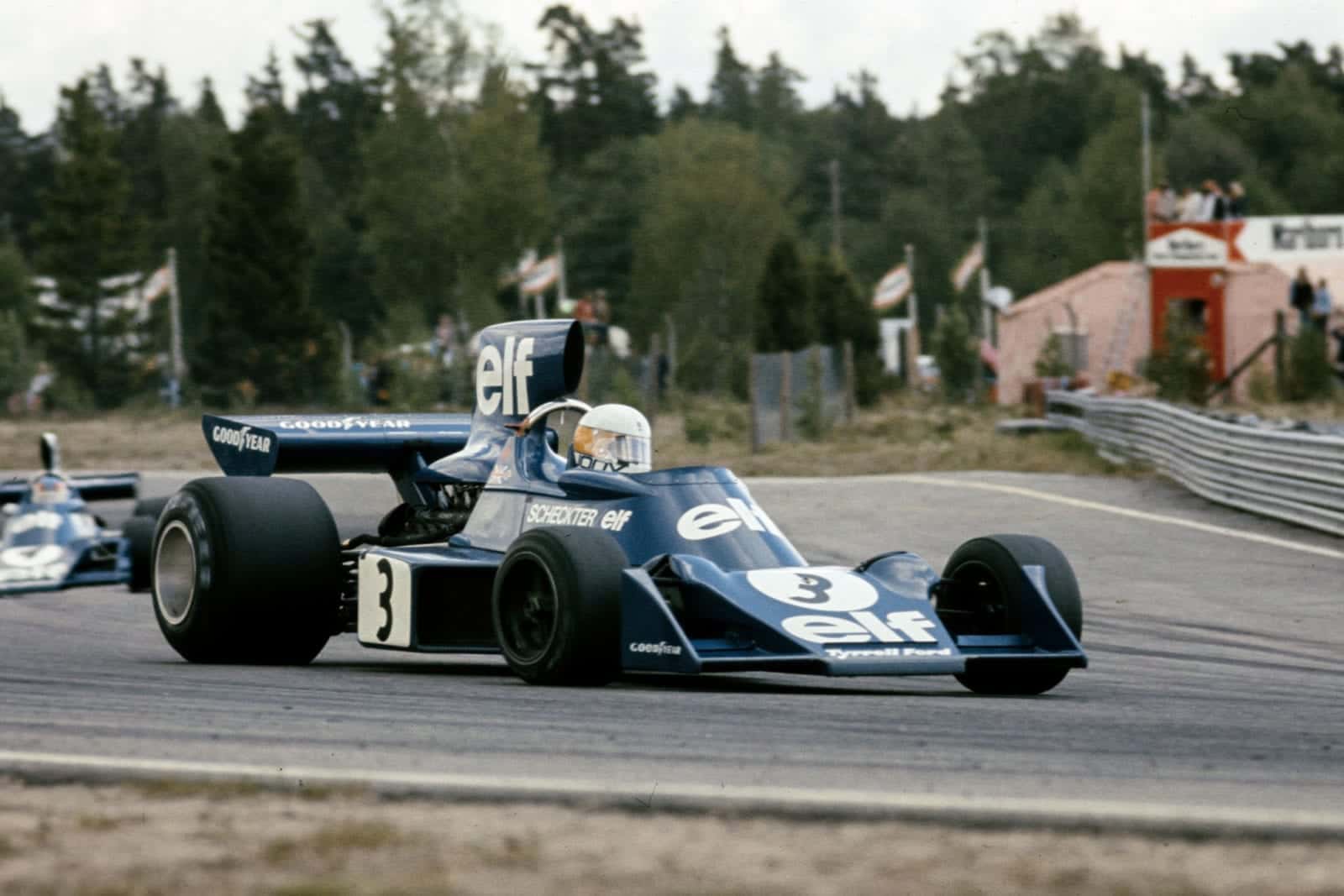
Jody Scheckter claimed a debut win for Tyrrell
Motorsport Images
A Tyrrell Double
Anderstorp. Yune 9th.
There were a few changes on the driver scene for the Swedish Grand Prix as drivers retired hurt, just retired or were busy doing something else. Arturo Merzario had broken a finger in an accident during the sports car race at Imola, the week before the Swedish event, so his place in the Frank Williams team was taken by Richard Robarts. In the March team Reine Wisell took the place of Hans-Joachim Stuck, as the forceful young German was competing in a Formula Two race at Hockenheim, having his sights set on winning the European Championship, and in the UOP-Shadow team Bertil Roos took over the place vacated by Brian Redman, the Lancastrian deciding that the rat-race of Formula One was not his way of living. Roos is a Swede who lives for the most part in America and does a lot of racing there in European-type National racing. With the total entry limited the BRM team decided not to be greedy with a three-car team, and dropped Francois Migault for this event. The organisers agreed to take 27 drivers for practice, the fastest 25 to take part in the race, though there was a clause in the supplementary regulations that allowed them to take the extra two drivers onto the starting grid if they should be Scandinavians! With advice from the Formula One Constructors Association the 27 drivers did not include Chris Amon, Tim Schenken and some newcomers, the exclusion of Ron Tauranac’s Trojan for Tim Schenken coming as a surprise to quite a few. On the mechanical front the scene was pretty stable, most of the crashed cars from Monaco having been repaired or completely rebuilt or even replaced. Team I.otus had the same formula as for Monaco, with Peterson on 72/R8 and Ickx on 72/R5, with this time the Lotus 76 number JPS/9 for Peterson to try as a spare car. The Tyrrell team of Scheckter and Depailler had the two t 974 cars, as raced previously, with Tyrrell 006/2 as a spare, though it was never used. The McLaren outfit had nearly a full set of M23 models, Hailwood having his usual pair, M23/t and M23/7 for the Yardley side of things, and Fittipaldi and I Mine having M23/5, M23/6 and M23/4 to race in Texaco-Marlboro colours, while on a trailer as advertising material was M23/2. Reutemann and von Opel had the usual three Brabham BT.44 models between them, and John Watson had BT42/2 for the Hexagon racing team. The March that Stuck crashed so extensively at Monaco was virtually scrapped and a new one built around the same identification plate: so that we can justifiably call it 741/1-2, in the same way that Brambilla’s car is 741/2-2 after being written-off in Spain earlier in the season. The Ferrari team’s neat arrangement of ringing the changes on their five cars was spoilt by Lauda at Monaco when he crumpled 015 in practice, and raced 010, so 015 was rebuilt for him to use in Sweden, 010 was given a rest, 012 was the spare car for this race and Regazzoni had on as planned. The two-car BRM team of Beltoise and Pescarolo comprised the two 1974 cars, the former having P201/01 and the latter having P201/02, it now having its front brakes mounted in the normal position of “inboard” for this model of BRM. The Swedish import to the Shadow team took over Redman’s car, while Jarier had his usual car, in long-wheelbase form, and the new and as yet unraccd car as a spare.
Tearn Surtees were not in the best of spirits, both drivers thinking it was time they started winning races, and were even unhappier than usual as John Surtees was not there for them to moan at. As mentioned, Robarts was acting as stand-in for Merzario, and his team-mate was the Danish driver Tom Heise. With time being short the Ensign team, backed by Theodore Racing of Hong Kong, brought along the 1973 car for Schuppan to drive, rather than hurriedly prepare the car used at Monaco, and Graham Hill and his young apprentice-driver Edwards, had the pair of Embassy-backed Lola cars that they had raced at Monaco, both looking immaculate and as if brand new, the cars that is, not the drivers. Hunt was driving his lordship’s Hesketh 308/2 and to complete the list there Was The Flying Finn, Leo Kinnunen with the prototype TS16 Surtees, carrying more Scandinavian advertising than seemed reasonable for its potential.
Since last year, when the first Swedish Grand Prix at Anderstorp was held and reckoned to be a huge success, the organisers and the Anderstorp Racing Club had tidied up a few ragged edges that occurred and everyone seemed very happy and contented. The circuit was modified slightly in that instead of zooming flat-out off the main straight, which is an airfield runway, through a right-hand sweep onto the wiggly part of the circuit, an ess-bend was built into the curve, so that the cars zoomed off the runway as usual, but then had to brake and lose speed through this ess -bend, to around 50 mph and then accelerate along a short straight to the first sharp corner on the infield. This effectively cut out the only fast corner on the flat circuit, it. being in the interests of safety we were told. What it did was provide opportunities for drivers to bounce wheels over the cambered kerbs of the ess-bend and promote an unprecedented series of breakages during the race. Initially it added a second or two to the lap time, but by the end of practice, lap times of the top group were well below the lap record of 1 min 26.146 secs, set up last year by Hulme. In spite of the long blast down the runway, the rest of the circuit is so wiggly that the lap speed is only just over 100 mph, fast enough for some Formula One aspirants, but hardly Grand Prix by motor racing standards.
Qualifying
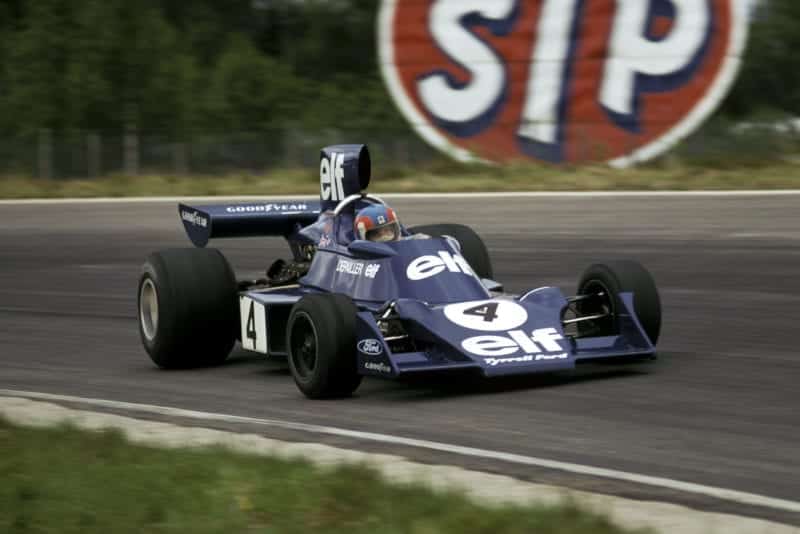
Depailler took Tyrrell’s first pole of the season
Motorsport Images
Practice was more than adequate, being in two sessions on Friday afternoon, and two on Saturday afternoon, though the time between the two sessions was not long enough for doing any really serious work. On Friday short sharp showers of rain messed things up, but in the dry spell Lauda showed form once more by setting the pace, with Peterson as usual charging along behind him in the Lotus 72. Scheckter was unobtrusively in third place, only a fraction of a second behind the Swede, followed by Fittipaldi and Janet recording good times. Merzario had a very brief try in the Williams car, but soon realised it was not possible to drive properly with his damaged hand, so the car was made ready for Robarts to drive in the second session. Regazzoni crumpled the front of his Ferrari very early on, and while it was repaired he did a few slow laps in the spare car. During the second session on Friday the rain played havoc and conditions were never completely dry so progress as far as lap times were concerned was backwards and it was latices turn to be fastest. Not a significant situation.
Early morning rain on Saturday was not encouraging, but the weather soon cleared and a warm sun dried things quickly. Everyone went off with a rush, conscious that the previous day’s practice had not really sorted out the grid positions, but almost as quickly everyone stopped. The electrical timing apparatus had gone on she blink, but it was soon rectified and practice got under way again. On the average Formula One car there are probably ten variables that affect lap times, and anyone who gets six right can reckon on being in the running, nobody ever getting ten out of ten, because some of the variables, like fuel load, tyre wear, temperatures and so on are continually changing. One important variable is driver ability, providing he has the opportunity to show it, but on the Anderstorp track this variable is neutralised by the simplicity of the dead flat circuit, so that an inferior driver with more of his variables right than a highly skilled driver, could appear to shine. By the end of the two Sessions this was illustrated by nine ‘rivers being grouped within one second. Some car/driver combinations never will go very fast, while others could but won’t and others would but can’t. The morale of the two Sunces drivers was so low that their times were not at all representative, Pace being only a fraction faster in the dry than Jarier was in the wet, and Pace is one of the hard-chargers when he feels like it. So is Jochen Mass, but they had both mentally given up due to a general discontent with no progress being made as the season wears on, apart from the disconcerting breakages they suffered at Monaco, but if the drivers do not try then they cannot hope to make any progress. One driver who really does keep on trying is Peterson, and though he drove the Lotus 76 very briefly, with huge temporary scoops on the side to gather more air for the radiators, it was with the Lotus 72 that he was concentrating his efforts. Between the two sessions on Saturday the Ferrari team took their gearboxes apart and altered the fourth and fifth ratios, it taking longer than thc interval, so that Lauda and Regazzoni lost some of the final practice time. This change had been prompted by Scheckter recording the fastest time at the beginning of Saturday practice, his driving being neat and tidy and adjusted nicely to the geometric configuration of the track, the Tyrrell 007 also being well suited to a circuit not calling for anything out of the ordinary, other than an honest balance. The Ferrari changes were no help, for Scheckter was still faster, and almost overlooked by the Maranello men was Denaliler, who went even faster than his team-mate, to get himself on pole position and be alone in breaking 1 minute 25 seconds for the circuit. Other than the two TyneIls being on the front row instead of the two Ferraris, as everyone expected, the disposition of everyone on the grid did not cause any particular excitement.
Race
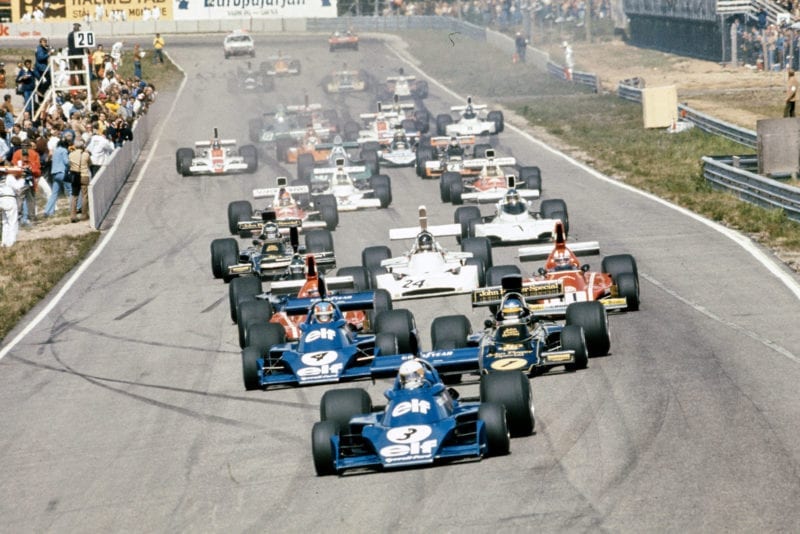
Scheckter steals a march on the field at the start
Motorsport Images
The weather forecast for Sunday was not too promising so a repeat of the Spanish Grand Prix pit-stop drama could be envisaged, and Team Lotus spent some time practicing wheel-changes. The pits at Anderstorp being small, primitive and crowded, the Formula One Constructors Association came up with an excellent idea of using the front of the pits and the back of the pits, to give more room.The organisers hurriedly ripped the back out of the existing pits, erected a barrier across the paddock to form a lane behind the pits, and Chapman (in pit number 1) and Tyrrell (in pit number 2) drew lots to see who should have the front pit and who should have the back pit. Chapman lost, so his team had to work from the back of the pits, while Tyrrell’s team worked from the front. From then on along the line of pits the team’s kept their same pit, but alternated front to rear, and everyone had much more space and was very happy. It was fortunate that the pit/paddock area had more than enough space available to allow plenty of room for the run-in and for the run-out. As things turned out the weather improved steadily, and the only clouds in the sky were light fluffy ones and the sun grew hotter all the time, but nobody doubted the wisdom of the double-sided pit idea. First thing in the morning, before a series of national races took place, everyone had the opportunity for a last final fling, with no times being recorded, and poor Tom Belso literally flung his Williams car up the road when the suspension collapsed on him. Although the race was not due to start until 1.30 p.m. there was no possibility of repairing it, so Robans was made to stand down and Belso took his car Fittipaldi also decided to change cars, preferring the feel of the spare McLaren to his usual one, these sort of last-minute changes being allowed by the 1974 CSI ruling, providing the driver does not change make of car.
After a warm up lap the cars formed up in grid order in front of the pits, with Kinunen taking the place of the unfortunate Robarts, while Schuppan, who was slowest in practice, was told to join in on the back just in case anyone dropped out, thus ensuring 25 cars starting. All 26 cars set off on the pace lap round to the starting line, led by the two ELF blue Tyrrell cars, everyone keeping station behind them. There was a pause on the starting grid and then everyone was away to start the so laps race, including Schuppan, as no-one had signalled anything to him. While Peterson was carving his way through from the third row, to tuck in behind Scheckter, who had made a good start, Depaillcr was not so quick and had to follow the black and gold Lotus into the first corner. While all this was going on Pescarolo’s BRM was developing flames around the back end, and while the field went away on the opening lap the BRM pulled off the track and was doused by the fire-marshals. Scheckter led from Peterson, Depailler, Lauda, Regazzoni, Reutemann, Hunt, Jarier, lckx, Fittipaldi, Millwood and Hulme and on only the second time round Roos retired to the pits with a broken gearbox, while next time round Beltoise did likewise with a broken engine.
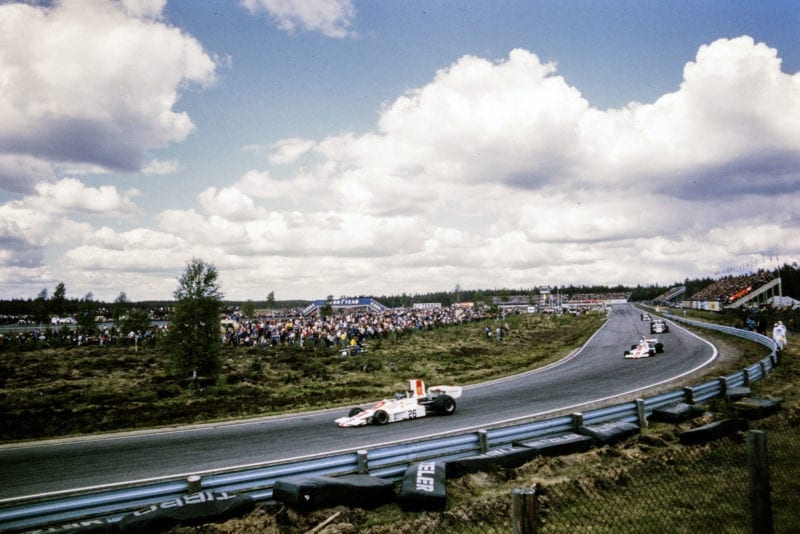
Graham Hill heads the midfield gaggle
Motorsport Images
With a clear road in front, Scheckter begot to pull out a small lead, while the rest down to Hailwood ran nose-to-tail, nobody looking like doing anything desperate. At six laps Hailwood coasted to a stop out on the circuit, a leak in the main fuel system cutting off the supply to the engine, and it was a case of follow-my-leader and sec who didn’t break down. At nine laps the front and the back of the field suffered a loss, Peterson coming to a stop with a broken rear drive-shaft and Kinnunen coming to a stop on the runway with a dead engine. The Lotus 72 retirement left the Tyrrell cars first and second and soon a situation of stale-mate set in, the circuit not encouraging anyone to do anything heroic. The field divided into two parts, the first one containing a procession of aces and professionals, with the cheeky Brambilla doing a splendid job hanging on to them, and the second part comprising the amateurs and also-rans, who were actually enjoying a little private battle far more than the front runners. Mass, Belso and von Opel were racing against other, while just ahead of them the tow Lolas were giving a nose-to-tail demonstration like the two Tyrrells out at the front of the race. One by one the enfeebled began to drop by the wayside, Reutemann calling at his pit with failing fuel pressure, only to find the back of the car covered in oil from the engine breathers, so it was withdrawn before it blew up. lckx stopped with electrical problems and then ‘ gave up altogether with low oil pressure, and Pace gave up in disgust. Regazzoni’s Ferrari broke its gearbox, and Lauda was not going as well as he should have done, for the right rear suspension was collapsing and the wheel was leaning inwards. His reduced pace was holding up Hunt, who had badly wanted to gel by, but there was no possibility round the wiggly part of the circuit, and the Hesketh could not out-speed the Ferrari down the straight. All the time the two Tyrrell’s were pulling further and further away into the distance, pit signals telling them to take it easy and drop their maximum rev-limit by 1000 r.p.m. There was no opposition behind them, with the remaining Ferrari sagging visibly, Hunt boxed in, the two McLarens of Fittipaldi and Hulme running so slowly that Brambilla was giving them trouble, and the charging Jarier having been deflated by first of all making a nonsense and missing a gear-change on the opening lap, and a little while later having the on-board fire-extinguisher system going off. It scented impossible that the two Tyrrell “new-boys” could be having it so good, but obviously Team Tyrrell had got more variables right than anyone else, and they were dead reliable with it. Watson and Wisell were having a nice little scrap together, for ninth place, but it did not last, as Watson had to stop to change a tyre on the brown Brabham, and Wisell went out at three-quarter race— distance when a pivot bolt in the rear suspension broke. Schuppan was having a lonely drive round on his own, right at the back of the field, but kept going as no-one signalled him to stop racing, and when it was all over he found himself excluded from the official results as he was not supposed to have started! Mass skated off the track when the front suspension of his Surtees broke (perhaps he does have cause for complaint) and Hulme dragged himself to a stop when the rear suspension broke on his McLaren. The troublesome rear suspension mounting point on Lauda’s Ferrari was gradually tearing the welded joint away, and as the wheel leant inwards the load was being trasmittcd to the final drive unit and the gearbox and the young Austrian was having difficulty changing gear. Finally the transmission gave up the unequal struggle and the second Ferrari retired to the pits, leaving Hunt a clear track at last. However, there were only ten laps to go, and though the blonde Englishman put on a stirring display in gaining ground on the two Tyrrells, even if he had caught them there would have been little hope of getting past them.
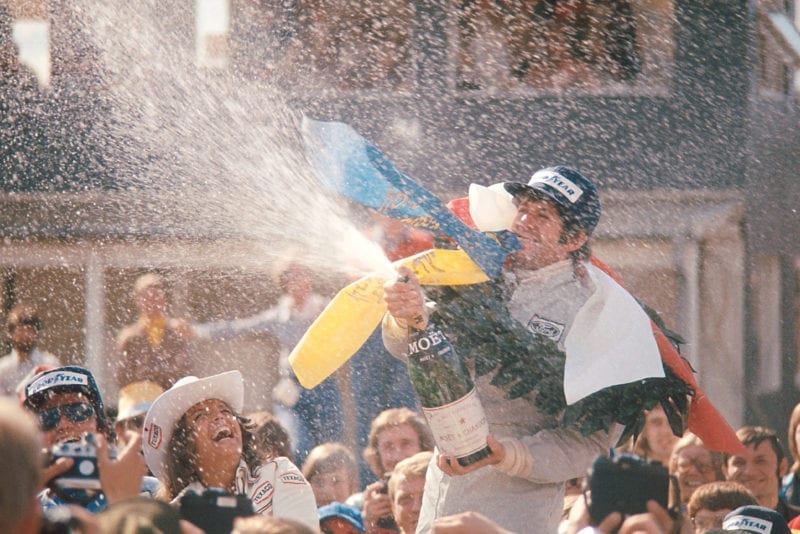
Scheckter sprays the champagne on the podium after winning
Motorsport Images
Both Scheckter and Depailler knew exactly what was going on, the South African setting just the right pace, with his agitated Franch team-mate close up behind him, and though the last minute flurry by Hunt and the Hesketh woke everyone from their stupor it was a bit meaningless, and the Tyrrells cruised home to an impressive 1-2, on reliability and practicality rather than genius and inspiration, those last two qualities being strewn around the circuit where their progenitors had fallen by the wayside. As the Tyrrells completed their last lap Brambilla’s March seized its Cosworth engine and coasted to a stop short of the finishing line, losing a worthy sixth place, dropping to tenth in the results. — D.S.J.
Results:
The Swedish Grand Prix – Formula One-80 laps—Seandiaavlan Raceway, Andorstorp 4.018 kilometres per lap-321.44 kilometres—Dry and sunny
1st: J. Scheckter (Tyrrell 007/1) 1hr. 58min. 31.391sec – 162.723 k.p.h.
2nd: P. Depailler (Tyrrell 007/2) 1hr. 58min. 31.771sec.
3rd: J. Hunt (Hesketh 308/2) 1hr. 58min. 34.716sec.
4th: E. Fittipaldi (McLaren M23/4) 1hr. 59min. 24.898sec.
5th: J-P. Jarier (Shadow DN3/2A) 1hr. 59min. 47.794sec.
6th: G. Hill (Lola T370/HU2) 1 lap behind
7th: G. Edwards (Lola T370/HU1) 1 lap behind
8th: T. Belso (Williams 1R/02) 1 lap behind
9th: R. von Opel (Brabham BT44/2) 1 lap behind
10th: V. Brambilla (March 741/2-2) 1 lap behind
11th: J. Watson (Brabham BT42/2) 3 laps behind
12th: V. Schuppan (Ensign MN01) 3 laps behind
